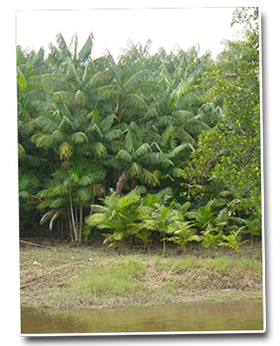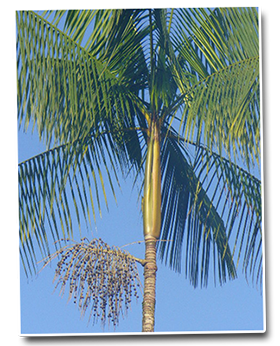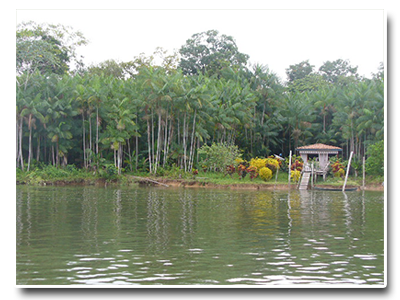Learn > The Tree

The açaí tree, Euterpe Oleracea Martius, is a slender palm that grows 15-20m tall and is native to the nutrient-rich floodplains of the Amazon, especially the Amazon River estuary. Several individual trunks grow out of a single root. This gives the açai palm a distinctive, attractive look, which is why it is often used as an ornamental plant in urban areas of the Amazon and the rest of Brazil.

In the rural areas of the Amazon the açai palm tree is an important natural resource. All of its components have specific uses: Its leaves are used to make thatched roofs, baskets and mats, the branched twigs on which the açai fruits grow become natural brooms and the hard, round seeds of the açai fruit are recycled as organic fertilizer, used as fuel and increasingly used to make necklaces, bracelets and other handicrafts.

Furthermore, besides bearing the açai fruit, the açai palm is also famous for its soft, inner core, namely the palm hearts that are used in salads and other "gourmet" dishes. Unfortunately, the extraction of palm hearts entails the cutting of the trees. While in some areas the palm hearts are extracted in a rational fashion (only the older palm trunks are cut), rational extraction is seldom the rule. Fortunately, as the economic importance of the açai fruit increases, so does the incentive of the farmers to preserve the palm trees for their fruit instead of cutting them down for their palm hearts.


 Furthermore, besides bearing the açai fruit, the açai palm is also famous for its soft, inner core, namely the palm hearts that are used in salads and other "gourmet" dishes. Unfortunately, the extraction of palm hearts entails the cutting of the trees. While in some areas the palm hearts are extracted in a rational fashion (only the older palm trunks are cut), rational extraction is seldom the rule. Fortunately, as the economic importance of the açai fruit increases, so does the incentive of the farmers to preserve the palm trees for their fruit instead of cutting them down for their palm hearts.
Furthermore, besides bearing the açai fruit, the açai palm is also famous for its soft, inner core, namely the palm hearts that are used in salads and other "gourmet" dishes. Unfortunately, the extraction of palm hearts entails the cutting of the trees. While in some areas the palm hearts are extracted in a rational fashion (only the older palm trunks are cut), rational extraction is seldom the rule. Fortunately, as the economic importance of the açai fruit increases, so does the incentive of the farmers to preserve the palm trees for their fruit instead of cutting them down for their palm hearts.
